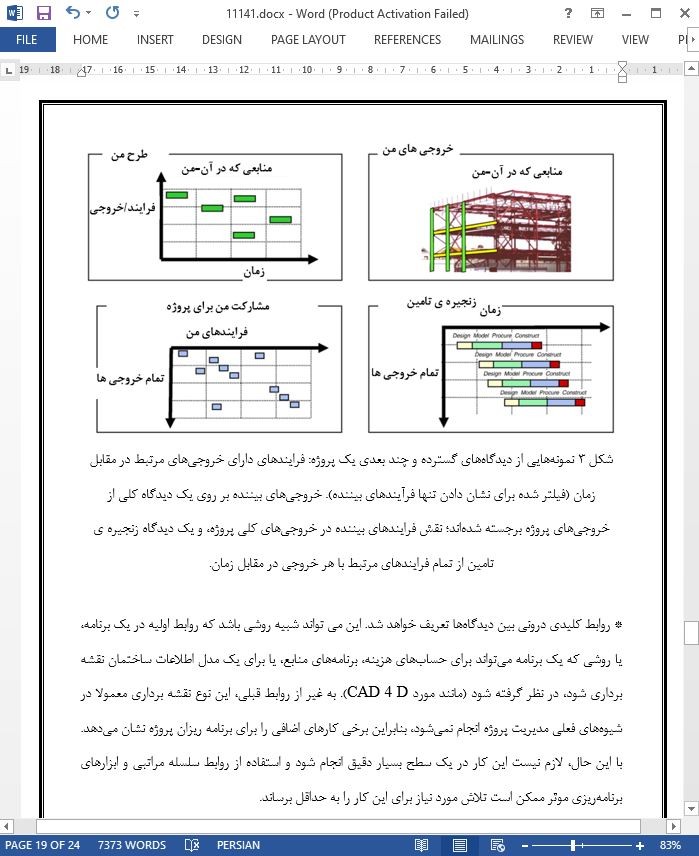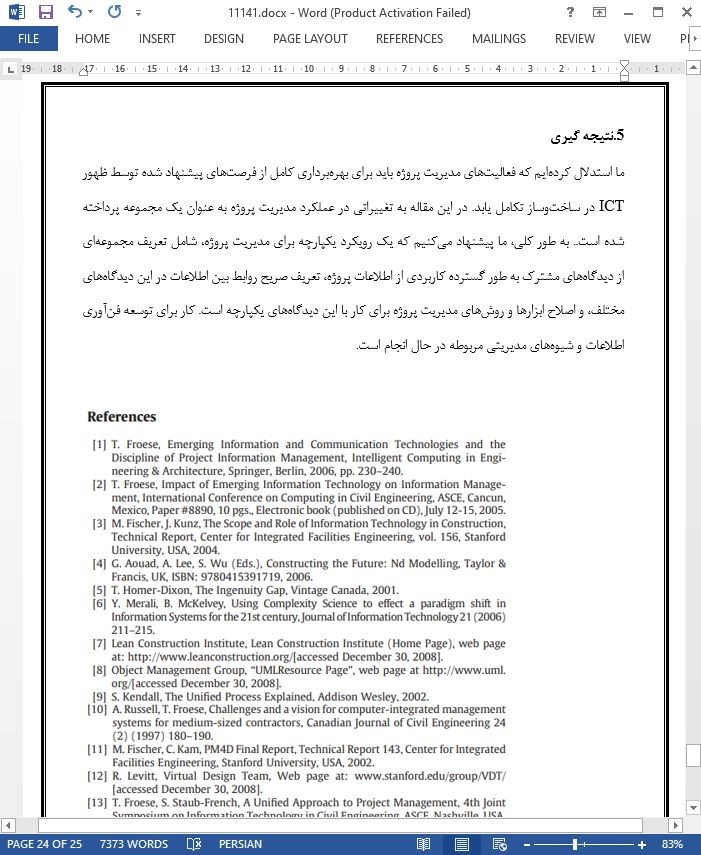
تاثیر ظهور فناوری اطلاعات بر مدیریت پروژه ساخت و ساز
چکیده
تغییرات ناشی از پیشرفت در فنآوری اطلاعات و ارتباطات برای صنایع مهندسی، معماری و ساختوساز (ICT ساختوساز)صرفا فنی نیستند، بلکه باید با تغییراتی در فرآیندهای مدیریتی همراه شوند. در جای دیگری، ما در مورد چارچوبی برای مدیریت اطلاعات پروژه در ساختوساز بحث کردهایم. این مقاله به تغییرات در روند مدیریت پروژه به طور کلی میپردازد. به طور کلی، یک رویکرد واحد را برای مدیریت پروژه پیشنهاد میکند که شامل تعریف مجموعهای از دیدگاههای مشترک به صورت گسترده کاربردی از اطلاعات پروژه، تعریف صریح روابط بین اطلاعات در این دیدگاههای مختلف، و اصلاح ابزارها و روشهای مدیریت پروژه برای کار با این دیدگاههای یکپارچه است.
1.مقدمه
گرایشهای کنونی در فنآوری اطلاعات و ارتباطات (ICT)طیف گستردهای از ابزارهای جدید مبتنی بر کامپیوتر را برای حمایت از صنایع معماری، مهندسی، ساختوساز و مدیریت امکانات ارائه میدهد (که در مجموع به عنوان ساختوساز در این مقاله مورد اشاره قرار میگیرند). این ابزارها به ویژه آنهایی که با مدلهای اطلاعات ساختمان (BIMs)برای مدلسازی پروژه و یکپارچهسازی در ارتباط هستند، افزایش زیادی در اثربخشی و کارایی طراحی و مدیریت پروژههای ساختوساز را وعده میدهند. با این حال، این بهبودها به چیزی بیش از راهحلهای فنی نیاز دارند؛پتانسیل کامل آنها بدون تغییر در وظایف کاری و مجموعه مهارتهای شرکت کنندگان در پروژه تحقق نمییابد. ما در حال بررسی رابطه ی بین پیدایش(ظهور) ICT و مدیریت پروژه هستیم و، به طور خاص، اینکه چگونه مدیریت پروژه باید برای بهرهبرداری کامل از پتانسیل ICT در حال ظهور تکامل یابد. در جای دیگر [ ۱ ] ما در مورد یک رشته ی فرعی خاص از مدیریت اطلاعات پروژه و نقش افسر اطلاعات پروژه بحث کردهایم. در این مقاله برای شناخت، نشان دادن، و مدیریت وابستگیهای متقابل بین دیدگاههای مختلف پروژه، یک چارچوب مفهومی برای یک رویکرد یکپارچه در مدیریت پروژه ارائه میشود.
5.نتیجه گیری
ما استدلال کردهایم که فعالیتهای مدیریت پروژه باید برای بهرهبرداری کامل از فرصتهای پیشنهاد شده توسط ظهور ICT در ساختوساز تکامل یابد. در این مقاله به تغییراتی در عملکرد مدیریت پروژه به عنوان یک مجموعه پرداخته شده است.. به طور کلی، ما پیشنهاد میکنیم که یک رویکرد یکپارچه برای مدیریت پروژه، شامل تعریف مجموعهای از دیدگاههای مشترک به طور گسترده کاربردی از اطلاعات پروژه، تعریف صریح روابط بین اطلاعات در این دیدگاههای مختلف، و اصلاح ابزارها و روشهای مدیریت پروژه برای کار با این دیدگاههای یکپارچه است. کار برای توسعه فنآوری اطلاعات و شیوههای مدیریتی مربوطه در حال انجام است.
Abstract
Changes brought about from advances in information and communication technology for the architecture, engineering, and construction industries (construction ICT) are not purely technical, but must be accompanied by changes to the management processes. Elsewhere, we have discussed a framework for project information management in construction. This paper addresses changes to the practice of project management as a whole. Broadly, it suggests a unified approach to project management that involves defining a set of widely-applicable common views of the project information, explicitly defining the inter-relationships between the information in these different views, and modifying project management tools and procedures to work with these integrated views.
1. Introduction
Current trends in information and communication technology (ICT) are yielding a wide range of new computer-based tools to support the architecture, engineering, construction and facilities management industries (collectively referred to simply as “construction” in this paper). These tools—particularly those associated with building information models (BIMs) for project modeling and integration— promise great increases in the effectiveness and efficiency of designing and managing construction projects. However, these improvements require more than just technical solutions; their full potential cannot be realized without corresponding changes in the work tasks and skill sets of the project participants. We are exploring the relationship between emerging ICT and project management and, in particular, how project management should evolve to fully exploit the emerging ICT potential. Elsewhere [1] we have discussed a specific sub-discipline of project information management and the role of a Project Information Officer. This paper considers adaptations to the overall practice of project management to more explicitly recognize, represent, and manage the interdependencies between different project views, presenting a conceptual framework for a unified approach to project management.
5. Conclusions
We have argued that project management practices should evolve to fully exploit the opportunities offered by emerging construction ICT. This paper has addressed changes to the practice of project management as a whole. Broadly, we suggest that a unified approach to project management involves defining a set of widely-applicable common views of the project information, explicitly defining the inter-relationships between the information in these different views, and modifying project management tools and procedures to work with these integrated views. Work is ongoing to develop both the information technology and the corresponding management practices.
چکیده
1.مقدمه
1.1. ساخت و ساز ICT در حال ظهور
2.1. انواع تاثیر بر مدیریت پروژه
2. ویژگیهای دیدگاهها و وابستگیهای متقابل در مدیریت پروژه
1.2. پیچیدگی و وابستگی در پروژههای ساختوساز
2.2. دیدگاه ها و یکارچگی در رویکردهای مدیریت پروژه
3.2. دیدگاهها و یکپارچگی در اطلاعات پروژه
4.2. افزایش ادغام در ساختوساز و صنایع دیگر
3. راه حل های مدیریت: یک رویکرد یکپارچه برای مدیریت پروژه
1.3. روش پایه
2.3. دیدگاهها
3.3. دیدگاه های اولیه
4.3 دیدگاه وابستگی متقابل
5.3. دیدگاه های ثانویه
3.6. کارکردن با رویکرد متحد برای مدیریت پروژه
3.7. به سمت طراحی و ساخت مجازی
4. راه حل های فنی: ابزارهای ICT برای حمایت از رویکرد یکپارچه برای مدیریت پروژه
5.نتیجه گیری
abstract
1. Introduction
1.1. Emerging construction ICT
1.2. Types of impact on project management
2. Characteristics of views and interdependencies in project management
2.1. Complexity and interdependencies in construction projects
2.2. Views and integration in project management approaches
2.3. Views and integration in project information
2.4. Increasing integration in construction and other industries
3. Management solutions: a unified approach to project management
3.1. The basic approach
3.2. Views
3.3. Primary views
3.4. View interdependency
3.5. Secondary views
3.6. Working with the unified approach to project management
3.7. Towards virtual design and construction
4. Technical solutions: ICT tools to support the unified approach to project management
5. Conclusions
- اصل مقاله انگلیسی با فرمت ورد (word) با قابلیت ویرایش
- ترجمه فارسی مقاله با فرمت ورد (word) با قابلیت ویرایش، بدون آرم سایت ای ترجمه
- ترجمه فارسی مقاله با فرمت pdf، بدون آرم سایت ای ترجمه



